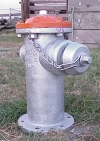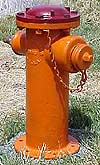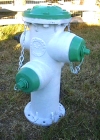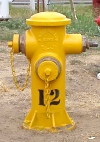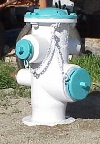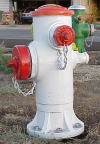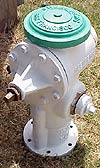Willis Lamm's Hydrant Collection
Part 5
All hydrants restored by and pictures Copyright © 2000, Willis Lamm.
| Click pictures for closeups |
0607
|
0646
|
0588
|
0583
|
0645
|
0604
1930s Model 75
|
0626
|
0620
|
0513
|
0587
|
0767
| ||||
More hydrants will be presented when restored.
0588- SF hydrants are painted white. This one was installed
on Treasure Island for the World's Fair. The island was taken
over by the Navy during WW-II and they painted the hydrants yellow.
This hydrant also differs from conventional SFFD hydrants as its
caps are brass rather than cast iron in order to resist corrosion
from the salt air.
0587- The "LA Sleeve" was originally designed when stem guides and
nozzles were seated in lead. With conventional hydrants the valves
had to be serviced and seals replaced by removing the flanged bonnet
and reaching down into the hydrant. Southern California preferred
a design where the entire valve assembly could be removed out the back
of the hydrant. Later with improved casting and machining techniques,
hydrant nozzles could be threaded on, therefore they could be removed
in the field and the valve passed out the opening for service and
seal replacement.
0587- The vertical bulge on the back of the hydrant contained a rod
which held open a clapper valve called a "breakaway valve." If the
hydrant was knocked off, the rod went with it and the valve slammed
shut preventing a large geyser and resulting water damage.
| ||||
Other "Willis" Collection Pages | |
"California" Hydrants |
More "California" Hydrants |
Dry Barrels |
"Mushroom Heads" |
Major Wet Barrel Makers |
Smaller Wet Barrel Makers |
Modern Wet Barrels | |
M. Greenberg's SonsEast Bay MUD HydrantsA House Founded Upon its Brass |
Back to Hydrant Collectors Page |
|
|
Unless otherwise noted, all contents of these WWW pages © 1996-00, FireHydrant.org This site designed and maintained by JikTek |
